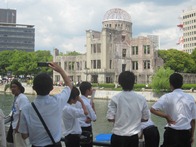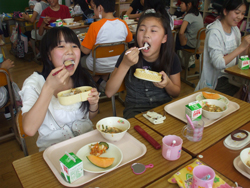 In August, the Association of Medical Doctors of Asia (AMDA) carried out a sports exchange in Okayama Prefecture. The program brought 46 junior high school soccer players aged 12–15 and 6 teachers representing 3 different schools in Iwate and Miyagi Prefectures. In addition, 123 students from 4 junior high school soccer teams in Okayama Prefecture participated. The program was intended to deepen the friendship and understanding between the students from the affected areas of Tohoku and their counterparts in Okayama Prefecture as a way to build solidarity and show the children that they are not alone in their efforts to rebuild. The program started with a moment of silent prayer for the victims of the earthquake and tsunami and for a brighter future for the young survivors. The children then participated in a soccer tournament in Soja City. Students stayed with local families, sharing their thoughts and experiences with their hosts. They then traveled to Okayama City to participate in a mixed team tournament that had students playing with teammates from other schools. The students also traveled to Hiroshima and to the Great Hanshin-Awaji Earthquake Memorial in Kobe. One participant noted, “I was encouraged by the historic scenes of Hiroshima and Kobe. The survivors made every effort to rebuild their regions after the devastation. I realized that I want to be a person who can rebuild Tohoku.”
In August, the Association of Medical Doctors of Asia (AMDA) carried out a sports exchange in Okayama Prefecture. The program brought 46 junior high school soccer players aged 12–15 and 6 teachers representing 3 different schools in Iwate and Miyagi Prefectures. In addition, 123 students from 4 junior high school soccer teams in Okayama Prefecture participated. The program was intended to deepen the friendship and understanding between the students from the affected areas of Tohoku and their counterparts in Okayama Prefecture as a way to build solidarity and show the children that they are not alone in their efforts to rebuild. The program started with a moment of silent prayer for the victims of the earthquake and tsunami and for a brighter future for the young survivors. The children then participated in a soccer tournament in Soja City. Students stayed with local families, sharing their thoughts and experiences with their hosts. They then traveled to Okayama City to participate in a mixed team tournament that had students playing with teammates from other schools. The students also traveled to Hiroshima and to the Great Hanshin-Awaji Earthquake Memorial in Kobe. One participant noted, “I was encouraged by the historic scenes of Hiroshima and Kobe. The survivors made every effort to rebuild their regions after the devastation. I realized that I want to be a person who can rebuild Tohoku.”
The Association for Aid and Relief (AAR) Japan reported that it remains uncertain when the elementary and junior high schools within 30 km of the Fukushima Daiichi Nuclear Power Plant will be able to resume operations. Students who used to attend schools in Minamisoma’s Haramachi and Odaka Wards are being bused to three elementary schools and one junior high school in Kashima Ward. Despite its limited budget, Kashima Ward has been providing lunches to all of the additional students, although it could only spend as little as ¥200 per lunch in July. It had used up its rice supply by the end of June, and the nuclear power plant accident has made it difficult to get reasonably priced local vegetables. The result was that it was difficult to provide nutritionally balanced lunches.
 Hearing of the situation from the Minamisoma Board of Education, AAR delivered 2 tons of rice and 16,802 cans of vegetable juice (enough for 2 servings per week) to schools in Kashima Ward. The initial round of supplies was completed on July 22, and AAR is planning to rent a truck to provide additional food from August 25 to September 24 for the start of the second semester. Other donors around the country are also chipping in, helping to provide a healthier menu for these young earthquake survivors.
Hearing of the situation from the Minamisoma Board of Education, AAR delivered 2 tons of rice and 16,802 cans of vegetable juice (enough for 2 servings per week) to schools in Kashima Ward. The initial round of supplies was completed on July 22, and AAR is planning to rent a truck to provide additional food from August 25 to September 24 for the start of the second semester. Other donors around the country are also chipping in, helping to provide a healthier menu for these young earthquake survivors.
